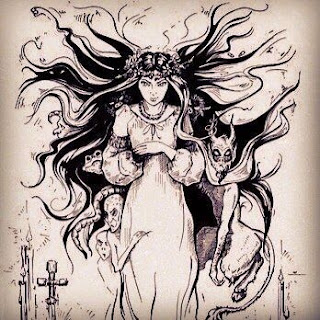As the Russian Orthodox Church celebrates its Christmas - which is beholden to the arrival of the Wise Men at the birthplace of Yeshua / Jesus, instead of the Catholic / Western (and very much Pagan-appropriative) date of December 25th - so my focus turns somewhat unusually to Russia, a place where paganism and native traditions are seldom practiced these days.
Now of course, for a large part the Pagan traditions of those most populous parts of Russia, where most natives are descended from the Rus, the indigenous culture is not "Russian", but it is in fact Slavic.
Slavic Paganism, much like Celtic Paganism, has variations spread across a great spreading region, from the Baltic, to the Aegean Sea, to the Ural Mountains, with deities sharing similar aspects, but only somewhat similar names. So it will probably surprise nobody, that Marena is a goddess who has previously been mentioned, in a fashion, on this blog.
Where folk tales tell of Morana in other regions, they see her as a counterpart of Vesna - a goddess of Summer who fell in love with Jarilo, a fertility god, and also her brother, who eloped with her at the end of Springtime. When Jarilo betrayed Vesna, it is said that her heartache transformed her into Morana, and turned her dark, morbid, and cold.
Commonly across Slavic folk tradition, any goddess like Marena or Morana will arrive with the Autumn. Though they see it as her taking the turn of the Spring goddess, who is known in Russian folklore as Kostroma - essentially the name by which the Russians know Vesna.
Before Kostroma arrives at Spring Equinox, most Slavic folk spring traditions will see Marena off into the Underworld, where she will stay for the next six months. In Slavic tradition, the people of a village would do this by dipping an effigy of Marena - which is known most popularly in neighbouring Poland as the Marzanna (Mar-ji-arr-nah) - and in Poland this tradition of parading the Marzanna, and dipping her at ponds, puddles, and other bodies of water, has carried on through the centuries.
However, with most Slavic communities having been sanitised by Christianity, the ceremony has been one turned very much against this feminine representation of winter. The Drowning of the Marzanna is seen as a malicious and vengeful act against the winter, by those who have survived her cold and deathly touch. Not only is the Marzanna effigy these days forcibly drowned in bodies of water, and sent away at a sea, river, or lake, but she is even set aflame!
It is a saddening shame, of course, that this violation of the sacred feminine turns her sacred aspects, into negative things, which lead to her being “disposed of”, as this effigy, by communities which once respected Marena, in all her names, faces, and guises.
While she is still present with us, in Winter, as it is celebrated by Christians across Russian culture, let us raise a toast to this mother of winter, and darkness, and cold, in all her glory!
За наших милых дам, Марена!
To our lovely lady, Marena!




Comments
Post a Comment